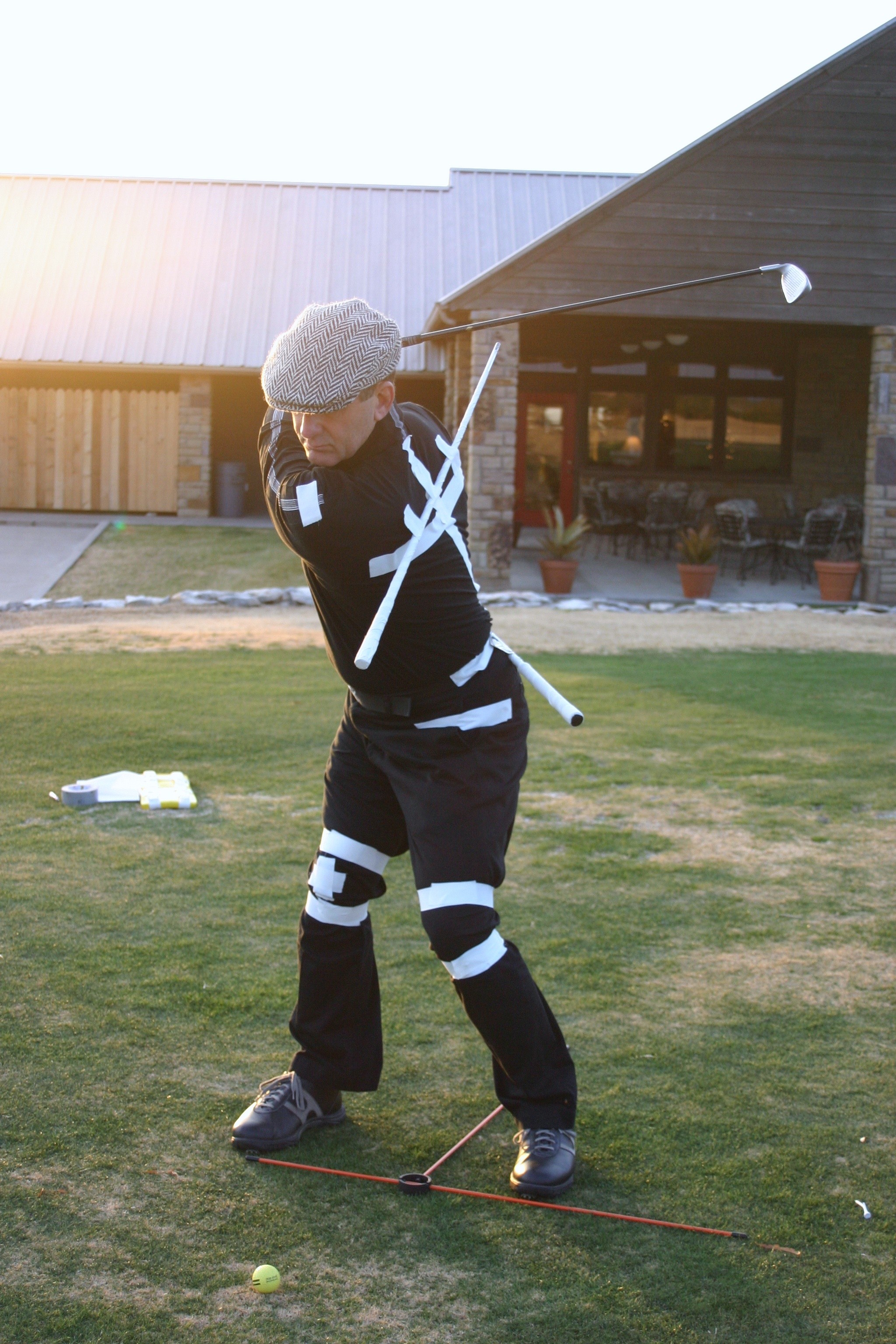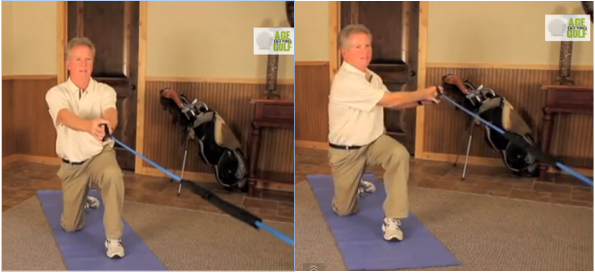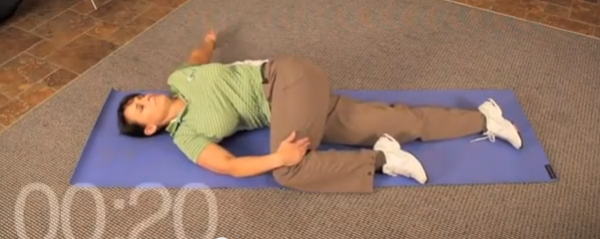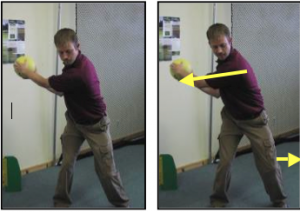Instruction
Stiffness and the slice go together

Yes, this is another article about correcting the golf slice.
If you have unsuccessfully tried to overcome the golf slice, the cause may be less about technique and more about the body, especially if you are over 50 or have a lot of body stiffness.
In this article, I hope to help you improve your body to be able to move correctly. Then, I’ll explain how you can teach your body to use its new ability in order to engrain a great golf move.
The No. 1 cause of hitting a slice in golfers over 50 is disassociation, the ability to move the upper body separately from the lower body. Not only do you need to have the flexibility to separate your upper body and lower body turn, but your body needs to be able to fire those parts of the body the correct sequence.
The moment of truth in a golf swing is the first move a golfer makes at the top of the backswing. Being able to initiate the downswing with lower body rotation without allowing the upper body to rotate open yet (and that is the key) will determine the golfers swing path into the ball.
The worst case scenario is if the upper body begins the downswing, which can cause an over-the-top move. Golfers often refer to this move as being “too quick from the top,” a flaw that occurs in golfers of all ages and skill levels. However, many golfers over 50 with poor golf flexibility tend to get “quick from the top” more often, or rotate their lower body and upper body at the same time. Not only will these moves often result in a slice, but they also decrease power. It is what my 3-year-old refers to as a “weeny swing.”
Fix the Body
Before we can begin to engrain a great transition move, we need to change the body so it has the ability to transition correctly. We want to include a passive (non-moving) stretch and an active stretch. Active stretches are important because they include muscle action in the process of muscle lengthening. This can help “cement” range of motion gains.
1. Passive Stretch to Improve Disassociation
Begin by lying on your right side. Bend your left knee up as shown. From here, rotate your upper body in the opposite direction with your left arm extended back. You should be able to touch the floor with both your left elbow and left knee at the same time. If you cannot, perform this stretch anywhere from 3-to-10 times daily for 20-to-30 seconds at a time.
2. Active Stretch

This is a great active stretch to improve disassociation because it can fixate the lower body by having one knee up. This allows golfers to rotate only their upper body.
Use an exercise band with this exercise. Perform 15 reps and switch (having the opposite knee up).
The other key to eliminating the slice caused by a body fault is to retrain your muscle patterning, or “muscle memory.” We want your lower-body muscles to remember to fire before your upper-body muscles.
If golfers start their downswing this way, it is nearly impossible to come over the top. A golfer may still slice, but it probably won’t be because of their swing plane.
There are a couple exercise you can do.
1. With a Partner
A great way to work on training the body to move correctly is to work on rotating the lower body with a partner/spouse holding the shoulders stable.
Here is how to do it:
Get into your golf stance without a golf club and fold your arms. Have your partner place hands on both shoulders and hold the upper body in place. From here, work on rotating your lower body back and forth without allowing your shoulders to move. Move back and forth for 30 seconds.
The key to remember with this exercise is that you are NOT trying to rotate very far, just back and forth to train the upper body to disassociate from the lower body.
This is the “go to” exercise I use with clients everyday, and is simply called “Transition Move Training.”
To work on the transitional move, begin in your normal golf stance. Take your backswing and hold the position.
You can make the transition move in 2 ways:
1. Slightly rotate your hips to the target making sure the shoulders do not open.
Most golfers over 50 will not have the flexibility to do this. The tendency is to allow the shoulders to open along with the hips. it can be tough to feel, so it is best to watch the shoulders in the mirror until a feel for it is developed.
If you find you are unable to keep your shoulders still, I suggest using the alternative transition move.
2. At the top of the backswing, slide the left knee to the target. Again, do not let the shoulders open.
From here, a golfer can finish the swing.
“Other” Causes
If a golfer is moving the lower body correctly and continues to slice, the cause of the slice narrows down to only a few options. Golfers are either holding onto their release instead of allowing the hands to rotate through the ball, or the arms are lagging behind the rest of the body and the clubface is late to the party. These issues have other causes.
I hope you enjoy these exercises and see the improvement in your game!
- LIKE5
- LEGIT0
- WOW0
- LOL0
- IDHT0
- FLOP0
- OB0
- SHANK1
Instruction
Clement: Laid-off or perfect fade? Across-the-line or perfect draw?

Some call the image on the left laid off, but if you are hitting a fade, this could be a perfect backswing for it! Same for across the line for a draw! Stop racking your brain with perceived mistakes and simply match backswing to shot shape!
- LIKE0
- LEGIT0
- WOW0
- LOL0
- IDHT0
- FLOP0
- OB0
- SHANK1
Instruction
The Wedge Guy: The easiest-to-learn golf basic

My golf learning began with this simple fact – if you don’t have a fundamentally sound hold on the golf club, it is practically impossible for your body to execute a fundamentally sound golf swing. I’m still a big believer that the golf swing is much easier to execute if you begin with the proper hold on the club.
As you might imagine, I come into contact with hundreds of golfers of all skill levels. And it is very rare to see a good player with a bad hold on the golf club. There are some exceptions, for sure, but they are very few and very far between, and they typically have beat so many balls with their poor grip that they’ve found a way to work around it.
The reality of biophysics is that the body moves only in certain ways – and the particulars of the way you hold the golf club can totally prevent a sound swing motion that allows the club to release properly through the impact zone. The wonderful thing is that anyone can learn how to put a fundamentally sound hold on the golf club, and you can practice it anywhere your hands are not otherwise engaged, like watching TV or just sitting and relaxing.
Whether you prefer an overlap, interlock or full-finger (not baseball!) grip on the club, the same fundamentals apply. Here are the major grip faults I see most often, in the order of the frequency:
Mis-aligned hands
By this I mean that the palms of the two hands are not parallel to each other. Too many golfers have a weak left hand and strong right, or vice versa. The easiest way to learn how to hold the club with your palms aligned properly is to grip a plain wooden ruler or yardstick. It forces the hands to align properly and shows you how that feels. If you grip and re-grip a yardstick several times, then grip a club, you’ll see that the learning curve is almost immediate.
The position of the grip in the upper/left hand
I also observe many golfers who have the butt of the grip too far into the heel pad of the upper hand (the left hand for right-handed players). It’s amazing how much easier it is to release the club through the ball if even 1/4-1/2″ of the butt is beyond the left heel pad. Try this yourself to see what I mean. Swing the club freely with just your left hand and notice the difference in its release from when you hold it at the end of the grip, versus gripping down even a half inch.
To help you really understand how this works, go to the range and hit shots with your five-iron gripped down a full inch to make the club the same length as your seven-iron. You will probably see an amazing shot shape difference, and likely not see as much distance loss as you would expect.
Too much lower (right) hand on the club
It seems like almost all golfers of 8-10 handicap or higher have the club too far into the palm of the lower hand, because that feels “good” if you are trying to control the path of the clubhead to the ball. But the golf swing is not an effort to hit at the ball – it is a swing of the club. The proper hold on the club has the grip underneath the pad at the base of the fingers. This will likely feel “weak” to you — like you cannot control the club like that. EXACTLY. You should not be trying to control the club with your lower/master hand.
Gripping too tightly
Nearly all golfers hold the club too tightly, which tenses up the forearms and prevents a proper release of the club through impact. In order for the club to move back and through properly, you must feel that the club is controlled by the last three fingers of the upper hand, and the middle two fingers of the lower hand. If you engage your thumbs and forefingers in “holding” the club, the result will almost always be a grip that is too tight. Try this for yourself. Hold the club in your upper hand only, and squeeze firmly with just the last three fingers, with the forefinger and thumb off the club entirely. You have good control, but your forearms are not tense. Then begin to squeeze down with your thumb and forefinger and observe the tensing of the entire forearm. This is the way we are made, so the key to preventing tenseness in the arms is to hold the club very lightly with the “pinchers” — the thumbs and forefingers.
So, those are what I believe are the four fundamentals of a good grip. Anyone can learn them in their home or office very quickly. There is no easier way to improve your ball striking consistency and add distance than giving more attention to the way you hold the golf club.
More from the Wedge Guy
- The Wedge Guy: Golf mastery begins with your wedge game
- The Wedge Guy: Why golf is 20 times harder than brain surgery
- The Wedge Guy: Musings on the golf ball rollback
- LIKE88
- LEGIT14
- WOW6
- LOL1
- IDHT0
- FLOP4
- OB1
- SHANK8
Instruction
Clement: Stop ripping off your swing with this drill!

Not the dreaded headcover under the armpit drill! As if your body is defective and can’t function by itself! Have you seen how incredible the human machine is with all the incredible feats of agility all kinds of athletes are accomplishing? You think your body is so defective (the good Lord is laughing his head off at you) that it needs a headcover tucked under the armpit so you can swing like T-Rex?
- LIKE0
- LEGIT3
- WOW2
- LOL0
- IDHT0
- FLOP0
- OB0
- SHANK2
-

 19th Hole2 weeks ago
19th Hole2 weeks agoJustin Thomas on the equipment choice of Scottie Scheffler that he thinks is ‘weird’
-

 19th Hole2 weeks ago
19th Hole2 weeks ago‘Absolutely crazy’ – Major champ lays into Patrick Cantlay over his decision on final hole of RBC Heritage
-

 19th Hole3 weeks ago
19th Hole3 weeks agoTwo star names reportedly blanked Jon Rahm all week at the Masters
-

 19th Hole2 weeks ago
19th Hole2 weeks agoReport: LIV Golf identifies latest star name they hope to sign to breakaway tour
-

 19th Hole3 weeks ago
19th Hole3 weeks agoNeal Shipley presser ends in awkward fashion after reporter claims Tiger handed him note on 8th fairway
-

 19th Hole2 weeks ago
19th Hole2 weeks agoBrandel Chamblee has ‘no doubt’ who started the McIlroy/LIV rumor and why
-

 19th Hole1 week ago
19th Hole1 week agoLET pro gives detailed financial breakdown of first week on tour…and the net result may shock you
-

 Equipment2 weeks ago
Equipment2 weeks agoJason Day on his recent switch into Srixon ZX5 and ZX7 Mk II irons




















charles brown
Mar 24, 2014 at 6:24 pm
I shortened my golf swing to keep up with them young whippersnappers… can’t wait to pro-am with Gulbis and/or Wie…
Mike
Oct 8, 2013 at 10:13 am
I notice these stretches are only given for one side. Does these apply to us lefty’s, or should we do the opposite?
Hyoga
Oct 9, 2013 at 8:54 am
Why don’t you just do both sides ?
Ryan York
Oct 11, 2013 at 12:03 am
Mike, if you are a lefty you want to do the opposite side. However, in the long run you want to be consistent with both sides to make sure you are symmetrical, as asymmetry can lead to injuries. Thanks for the comment.
Ryan
Andrew Coop
Oct 4, 2013 at 6:06 am
Very good article Ryan and thanks for sharing this info. I’m in my mid 30s, so a little younger than your clients, but after 20 odds year of playing golf at a decent level, +1 hcp, my back started getting sore a couple of seasons back.
A couple of questions I’d be grateful if you could give your expert opinion on…Can you overdo the disassociation? I’ve always been able to hit hard (ss 110+mph), and as a young player always created lots of lag and seperation between upper and lower body. I look after myself, but I’ve found that my ability to do this has lessened in my mid30s. Can chasing this (when the body isn’t really up to it) hurt the back?
I’ve worked this year on moving everything more together from the top (less seperation), giving up some lag and my back feels much better-though I’ve lost some yardage.
Would be very interested to hear your thoughts. Thanks again for sharing your knowledge.
Ryan York
Oct 11, 2013 at 12:22 am
Andrew,
Thanks for your comment and question.
Joints that are too mobile can cause pain (also defined as an instability). this can lead to back pain and other issues down the road if not addressed.
What I would recommend is to continue to limit the disassociation for a while. Then improve the stability of your back.
Here are a couple of PDF websites with good back stabilization programs:
Princeton Back Stabilization
and/or
InTech-Back Stabilization
Try these for 8 weeks.
If your back feels better, you can begin to slowly reintroduce more disassociation in your swing.
If you don’t feel better, I would consult a local physical therapist.
If you are having back pain as a result of too much motion, it is likely that once vertebra is doing most of the movement, instead of all of them sharing the load. Good back stabilization will help.
Hope that points you in the right direction
Ryan
Andrew Coop
Oct 11, 2013 at 10:44 am
That’s great, thanks.